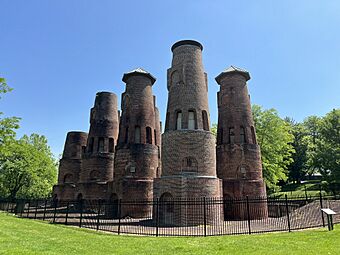Coplay Cement Company Kilns facts for kids
Quick facts for kids |
|
|
Coplay Cement Company Kilns
|
|

Coplay Cement Company Kilns, May 2024
|
|
| Location | N. 2nd St., Coplay, Pennsylvania |
|---|---|
| Area | 2.6 acres (1.1 ha) |
| Built | 1892–1893 |
| Built by | Coplay Cement Co. |
| Architectural style | Schoefer vertical |
| NRHP reference No. | 80003556 |
| Added to NRHP | September 2, 1980 |
The Coplay Cement Company Kilns, also known as the Saylor Park Industrial Museum, is a cool outdoor historical site in Coplay, Pennsylvania. These nine huge kilns were built a long time ago, between 1892 and 1893. They were used to make a super strong building material called Portland cement.
Contents
What Are the Coplay Cement Kilns?
These amazing kilns are made from red bricks found right in the area. They are a special type called Schoefer vertical kilns. The kilns stopped working in 1904. Later, in 1975, the Coplay Cement Company gave them and the land around them to Lehigh County.
A Special Museum for Cement History
The county turned the site into a museum. This museum celebrates how important the company and cement were to the area's early economy. Today, Lehigh County owns and takes care of the site. The Lehigh County Historical Society helps by providing educational programs. The kilns were added to the National Register of Historic Places in 1980.
David Saylor: The Father of American Cement
The Saylor Cement Museum honors David Saylor, who lived from 1827 to 1884. He is known as the "father of the American Portland cement industry." The museum also celebrates all the people who helped build this industry. It became very important in the Lehigh Valley and across the nation.
Why Lehigh County Was Perfect for Cement
Lehigh County was a natural place to make cement. Cement is made from rocks that contain lime, silica, and alumina. Luckily, the limestone found in Lehigh County, called "cement rock," already has all three of these ingredients!
How Portland Cement Changed America
In 1866, David O. Saylor helped start the Coplay Cement Company. In 1871, he received the first American patent for Portland cement. This type of cement was much stronger than the natural cement used before. Saylor's Portland cement was used to build many important things. It helped create bridges, docks, jetties, roads, aqueducts, subways, and even skyscrapers! By 1900, the Lehigh Valley was making 72% of all the Portland cement produced in the United States.
From Old Kilns to New Technology
The very first kiln at the Coplay Cement Company was a dome kiln. These dome kilns were not very efficient. They had to be shut down often to work properly.
The Schoefer Kilns Arrive
In 1893, Coplay Cement built "Mill B." This mill contained the Schoefer kilns you can see today. These kilns were originally inside a large building. A great thing about Schoefer kilns was that they could run all the time without stopping.
Why the Schoefer Kilns Closed
However, even more efficient machines called rotary kilns soon came along. Because of this new technology, the Schoefer kilns in Mill B became outdated. They were shut down in 1904. After that, the Coplay Cement Company used the buildings of Mill B for storage.



